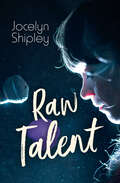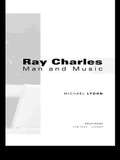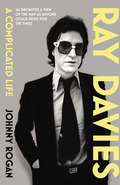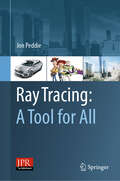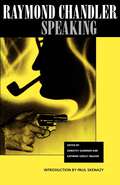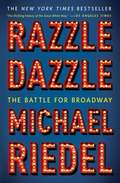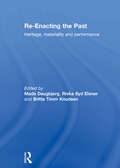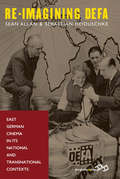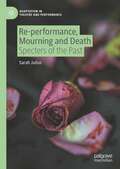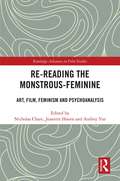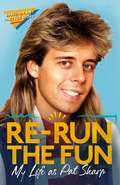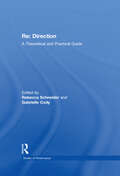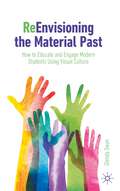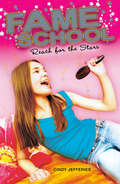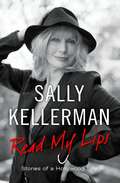- Table View
- List View
Raw Talent (Orca Limelights)
by Jocelyn ShipleyFourteen-year-old Paisley loves to sing. Paisley dreams of being a pop star just like her idol, Denzi, who also grew up in the small town of Stonehill. The problem is, Paisley suffers from severe stage fright. She can only sing in private. When word gets out that a famous Stratford actor who has worked with Denzi is staying at a local B&B, Paisley decides it's time to face her fears. She convinces the actor to tutor her and signs up to sing in a high-profile fundraiser. This short novel is a high-interest, low-reading level book for middle-grade readers who are building reading skills, want a quick read or say they don’t like to read!
Ray Charles: Man And Music
by Michael LydonAn extremely detailed account of Ray Charles' personal life, from his childhood to his death and funeral, and of his musical life, including every concert, gig, recording etc.
Ray Charles: Man and Music, Updated Commemorative Edition
by Michael LydonRay Charles: Man and Music is a complete biography of this seminal singer/pianist who has been active on the American music scene since the mid-'50s. Originally published in 1995 by Penguin Books, and universally hailed as the definitive biography, this new edition will bring Charles's life up to date, covering the last 7 years of his life.There are only a few legendary singers who have developed mass audiences while pursuing their own artistic visions: Sinatra is one; Ella Fitzgerald another. Ray Charles undoubtedly belongs in this pantheon of major musical stars. Ray Charles: Man and Music begins with Charles's impoverished childhood in Greenville, Florida, where tragedy struck early when the young Charles went blind at age 6 and was orphaned at age 14. Driven by his enormous talent and determination, Charles landed work playing some of the toughest juke joints in the state, fought heroin addiction, and finally landed a recording contract with Atlantic Records. Unlike other R&B singers, Charles took control of his career from its earliest days, moving on from his gospel-soul stylings of the mid-'50s to break through musical barriers, recording two country albums in the late '50s (at a time when the black presence in country music was barely felt), pure jazz, and then the powerful pop hits of the '60s. Famed music journalist Michael Lydon - a founding editor of Rolling Stone - is uniquely qualified to document Charles's career, having interviewed Charles and followed the star's performances since the 1960s. Originally published in 1995, and universally hailed as the definitive biography, this new edition brings Charles's life up to date, covering the last 7 years of his life. It coincides with the release of a made-for-TV movie starring Jamie Fox as Charles, currently in production by Taylor Hackford. Charles has also issued a new CD recently and remains active as a touring artist throughout the world.
Ray Charles: Soul Man
by Ruth TurkA biography of the popular singer, who became blind as a young boy.
Ray Davies: A Complicated Life
by Johnny RoganNOW UPDATED WITH A NEW EPILOGUE In the summer of 1964, aged twenty, Ray Davies led the Kinks to fame with their number one hit ‘You Really Got Me’. Within months, they were established among the pop elite, swamped by fans and fast becoming renowned for the rioting at their gigs. But Ray’s journey from working-class Muswell Hill to the Rock ’n’ Roll Hall of Fame was tumultuous in the extreme, featuring breakdowns, bitter lawsuits, spectacular punch-ups and a ban from entering the USA. His relationship with his brother Dave is surely the most ferocious and abusive in music history. Based on countless interviews conducted over several decades, this richly detailed and revelatory biography presents the most frank and intimate portrait yet of Ray Davies.
Ray Milland: Identity, Stardom, and the Long Climb to The Lost Weekend
by Gillian KellyRay Milland (1907–1986) was the inaugural Welshman to win the Best Actor Academy Award, as well as a performer boasting a rich and varied oeuvre from the silent era in 1920s Britain to New Hollywood in the 1980s. Despite being one of the most prolific actors in cinema history who left behind a legacy of almost 180 film and television appearances across seven different decades, Milland remains a somewhat forgotten figure of cinematic history. Ray Milland: Identity, Stardom, and the Long Climb to “The Lost Weekend” fills this void in scholarship by offering a detailed examination of Milland as one of Hollywood’s most durable and fascinating performers of the studio era. The volume begins by exploring Milland’s unique Welsh identity in Hollywood, which was essentially erased by the studios. It then turns to his underexplored early career at MGM prior to signing with Paramount Pictures, where he remained for over two decades. Author Gillian Kelly discusses his early roles as a stereotypical “Brit” in Hollywood as well as his “stardom years” at Paramount where he often provided support for the studio’s leading ladies, including Claudette Colbert, Dorothy Lamour, and Paulette Goddard. A chapter is dedicated to his Oscar-winning performance in The Lost Weekend, and important later films like Dial M for Murder and Love Story also receive detailed analysis. Overall, Ray Milland provides a reappraisal of Milland’s earlier career and situates his performances within the broader tradition of star studies.
Ray Tracing: A Tool for All
by Jon PeddieThis is the first book to offer a comprehensive overview for anyone wanting to understand the benefits and opportunities of ray tracing, as well as some of the challenges, without having to learn how to program or be an optics scientist.It demystifies ray tracing and brings forward the need and benefit of using ray tracing throughout the development of a film, product, or building — from pitch to prototype to marketing.Ray Tracing and Rendering clarifies the difference between conventional faked rendering and physically correct, photo-realistic ray traced rendering, and explains how programmer’s time, and backend compositing time are saved while producing more accurate representations with 3D models that move.Often considered an esoteric subject the author takes ray tracing out of the confines of the programmer’s lair and shows how all levels of users from concept to construction and sales can benefit without being forced to be a practitioner. It treats both theoretical and practical aspects of the subject as well as giving insights into all the major ray tracing programs and how many of them came about.It will enrich the readers’ understanding of what a difference an accurate high-fidelity image can make to the viewer — our eyes are incredibly sensitive to flaws and distortions and we quickly disregard things that look phony or unreal. Such dismissal by a potential user or customer can spell disaster for a supplier, producer, or developer. If it looks real it will sell, even if it is a fantasy animation. Ray tracing is now within reach of every producer and marketeer, and at prices one can afford, and with production times that meet the demands of today’s fast world.
Raymond Chandler Speaking
by Raymond ChandlerTough-minded and typically idiosyncratic, here is Chandler on Chandler, the mystery novel, writing, Hollywood, TV, publishing, cats, and famous crimes. This skillfully edited selection of letters, articles, and notes also includes the short story "A Couple of Writers" and the first chapters of Chandler's last Philip Marlowe novel, The Poodle Springs Story, left unfinished at his death. Paul Skenazy has provided a new introduction for this edition as well as a new selected bibliography.
Razzle Dazzle: The Battle for Broadway
by Michael Riedel&“A vivid page-turner&” (NPR) detailing the rise, fall, and redemption of Broadway—its stars, its biggest shows, its producers, and all the drama, intrigue, and power plays that happened behind the scenes.&“A rich, lovely, debut history of New York theater in the 1970s and eighties&” (Kirkus Reviews, starred review), Razzle Dazzle is a narrative account of the people and the money and the power that turned New York&’s gritty back alleys and sex-shops into the glitzy, dazzling Great White Way. In the mid-1970s Times Square was the seedy symbol of New York&’s economic decline. Its once shining star, the renowned Shubert Organization, was losing theaters to make way for parking lots and losing money. Bernard Jacobs and Jerry Schoenfeld, two ambitious board members, saw the crumbling company was ripe for takeover and staged a coup and staved off corporate intrigue, personal betrayals and criminal investigations. Once Jacobs and Schoenfeld solidified their power, they turned a collapsed theater-owning holding company into one of the most successful entertainment empires in the world, spearheading the revitalization of Broadway and the renewal of Times Square. &“For those interested in the business behind the greasepaint, at a riveting time in Broadway&’s and New York&’s history, this is the ticket&” (USA TODAY). Michael Riedel tells the stories of the Shubert Organization and the shows that re-built a city in grand style—including Cats, A Chorus Line, and Mamma Mia!—revealing the backstage drama that often rivaled what transpired onstage, exposing bitter rivalries, unlikely alliances, and inside gossip. &“The trouble with Razzle Dazzle is…you can&’t put the damn thing down&” (Huffington Post).
Re-Enacting the Past: Heritage, Materiality and Performance
by Mads Daugbjerg, Rivka Syd Eisner and Britta Timm KnudsenWhat is re-enactment and how does it relate to heritage? Re-enactments are a ubiquitous part of popular and memory culture and are of growing importance to heritage studies. As concept and practice, re-enactments encompass a wide range of forms: from the annual ‘Viking Moot’ festival in Denmark drawing thousands of participants and spectators, to the (re)staged war photography of An-My Lê, to the Titanic Memorial Cruise commemorating the centennial of the ill-fated voyage, to the symbolic retracing of the Berlin Wall across the city on 9 November 2014 to mark the 25th anniversary of its toppling.Re-enactments involve the sensuousness of bodily experience and engagement, the exhilarating yet precarious combination of imagination with ‘historical fact’, in-the-moment negotiations between and within temporalities, and the compelling drive to re-make, or re-presence, the past. As such, re-enactments present a number of challenges to traditional understandings of heritage, including taken-for-granted assumptions regarding fixity, conservation, originality, ownership and authenticity. Using a variety of international, cross-disciplinary case studies, this volume explores re-enactment as practice, problem, and/or potential, in order to widen the scope of heritage thinking and analysis toward impermanence, performance, flux, innovation and creativity.This book was originally published as a special issue of the International Journal of Heritage Studies.
Re-Imagining DEFA: East German Cinema in its National and Transnational Contexts
by Sebastian Heiduschke Seán AllanBy the time the Berlin Wall collapsed, the cinema of the German Democratic Republic—to the extent it was considered at all—was widely regarded as a footnote to European film history, with little of enduring value. Since then, interest in East German cinema has exploded, inspiring innumerable festivals, books, and exhibits on the GDR’s rich and varied filmic output. In Re-Imagining DEFA, leading international experts take stock of this vibrant landscape and plot an ambitious course for future research, one that considers other cinematic traditions, brings genre and popular works into the fold, and encompasses DEFA’s complex post-unification “afterlife.”
Re-Purposing Suzuki: A Hybrid Approach to Actor Training
by Maria PorterRe-Purposing Suzuki: A Hybrid Approach to Actor Training introduces a system of text analysis that synthesizes physical, psychological, and vocal components in order to truthfully embody heightened texts and contexts. By understanding how the author has re-purposed Suzuki and other physical training methods, as well as Stanislavski, readers will gain an awareness of how to analyze a particular training method by extrapolating its key components and integrating it into a holistic, embodied approach to text analysis. The book explores a method of physical scoring via Rules of the Body and Rules of Composition, as well as a method of approaching heightened texts from Greek drama to post-modern playwrights that draws on the individual actor’s imagination and experience and integrates voice, mind, and body. Readers will be able to either replicate this approach, or apply the logic of its building blocks to assemble their own personal creative process applicable to a variety of performance genres. This is a source book for actors, theatre students, practitioners, and educators interested in assembling tools derived from different sources to create alternative approaches to actor training. While the process outlined in the book evolves in a classroom setting, the components of the pedagogy can also be practiced by individuals who are interested in finding new ways to explore text and character and bring them into their own personal practice.
Re-performance, Mourning and Death: Specters of the Past (Adaptation in Theatre and Performance)
by Sarah JuliusThis book examines the recent trend for re-performance and how this impacts on the relationship between live performance and death. Focusing specifically on examples of performance art the text analyses the relationship between performance, re-performance and death, comparing the process of re-performance to the process of mourning and arguing that both of these are processes of adaptation and survival. Using a variety of case studies, including performances by Ron Athey, Julie Tolentino, Martin O’Brien, Sheree Rose, Jo Spence and Hannah Wilke, the book explores performances which can be considered acts of re-performance, as well as performances which examine some of the critical concerns of re-performance, including notions of illness, loss and death. By drawing upon both philosophical and performance studies discourses the text takes a novel approach to the relationship between re-performance, mourning and death.
Re-reading the Monstrous-Feminine: Art, Film, Feminism and Psychoanalysis (Routledge Advances in Film Studies)
by Audrey Yue Nicholas Chare Jeanette HoornThis book provides a critical reappraisal of Barbara Creed’s ground-breaking work of feminist psychoanalytic film scholarship, The Monstrous-Feminine, which was first published in 1993. The Monstrous-Feminine married psychoanalytic thinking with film analysis in radically new ways to provide an invaluable corrective to conventional approaches to the study of women in horror films, with their narrow emphasis on woman’s victimhood. This volume, which will mark 25 years since the publication of The Monstrous-Feminine, brings together essays by international scholars working across a variety of disciplines who take up Creed’s ideas in new ways and fresh contexts or, more broadly, explore possible futures for feminist and/or psychoanalytically informed art history and film theory.
Re-run the Fun: My Life as Pat Sharp
by Pat Sharp Darren Richman Luke Catterson'The perfect antidote to 2020' Huffington Post'A must-read if you like funny things' Greg James'I had no idea Pat Sharp's life story would be so hilarious and I strongly suspect neither did he' Nish KumarPat Sharp is a man out of time.For those of a certain generation, he is an iconic figure synonymous with good fun, great hair and excess gunge. For others, he's just that bloke with a mullet. Fame is a fickle beast and, since the cancellation of Fun House in 1999 ('Just ten years into its run, when it was finally finding its feet'), Pat has become a reclusive figure, only emerging from his splendid isolation to pop up on things like I'm A Celebrity: Get Me Out Of Here, Never Mind the Buzzcocks and Come Dine with Me. Until now.With time on his hands and now reliant on a faulty memory, Pat has expertly blended fact and . . . fiction: revealing all about his adventures with David Hassselhoff at the Berlin Wall in 1989; how he broke up a fight between Damon Albarn and Liam Gallagher at a house party; the time he suggested Geri's dress be a Union Jack; and much more.A definitive work (based on very little fact) that anatomises the cultural trends of the '80s and '90s, Re-run the Fun is just the kind of sorta-biography we need in these turbulent times. Finally, the Great British public can learn what life is like just about in sight of the top - the highs, the lows and the hair tips.'It's easy to forget, as I had, that Pat Sharp is so much more than an iconic haircut and a helter-skelter - and this well overdue book goes into hilarious, largely-fabricated detail about Pat's critical role in shaping our world today' Rick Edwards'No previous knowledge of Pat Sharp is required' Paul Sinha
Re-run the Fun: My Life as Pat Sharp
by Pat Sharp Darren Richman Luke Catterson'The perfect antidote to 2020' Huffington Post'A must-read if you like funny things' Greg James'I had no idea Pat Sharp's life story would be so hilarious and I strongly suspect neither did he' Nish KumarPat Sharp is a man out of time.For those of a certain generation, he is an iconic figure synonymous with good fun, great hair and excess gunge. For others, he's just that bloke with a mullet. Fame is a fickle beast and, since the cancellation of Fun House in 1999 ('Just ten years into its run, when it was finally finding its feet'), Pat has become a reclusive figure, only emerging from his splendid isolation to pop up on things like I'm A Celebrity: Get Me Out Of Here, Never Mind the Buzzcocks and Come Dine with Me. Until now.With time on his hands and now reliant on a faulty memory, Pat has expertly blended fact and . . . fiction: revealing all about his adventures with David Hassselhoff at the Berlin Wall in 1989; how he broke up a fight between Damon Albarn and Liam Gallagher at a house party; the time he suggested Geri's dress be a Union Jack; and much more.A definitive work (based on very little fact) that anatomises the cultural trends of the '80s and '90s, Re-run the Fun is just the kind of sorta-biography we need in these turbulent times. Finally, the Great British public can learn what life is like just about in sight of the top - the highs, the lows and the hair tips.'It's easy to forget, as I had, that Pat Sharp is so much more than an iconic haircut and a helter-skelter - and this well overdue book goes into hilarious, largely-fabricated detail about Pat's critical role in shaping our world today' Rick Edwards'No previous knowledge of Pat Sharp is required' Paul Sinha
Re-run the Fun: My Life as Pat Sharp
by Pat Sharp Darren Richman Luke Catterson'The perfect antidote to 2020' Huffington Post'A must-read if you like funny things' Greg James'I had no idea Pat Sharp's life story would be so hilarious and I strongly suspect neither did he' Nish KumarPat Sharp is a man out of time.For those of a certain generation, he is an iconic figure synonymous with good fun, great hair and excess gunge. For others, he's just that bloke with a mullet. Fame is a fickle beast and, since the cancellation of Fun House in 1999 ('Just ten years into its run, when it was finally finding its feet'), Pat has become a reclusive figure, only emerging from his splendid isolation to pop up on things like I'm A Celebrity: Get Me Out Of Here, Never Mind the Buzzcocks and Come Dine with Me. Until now.With time on his hands and now reliant on a faulty memory, Pat has expertly blended fact and . . . fiction: revealing all about his adventures with David Hassselhoff at the Berlin Wall in 1989; how he broke up a fight between Damon Albarn and Liam Gallagher at a house party; the time he suggested Geri's dress be a Union Jack; and much more.A definitive work (based on very little fact) that anatomises the cultural trends of the '80s and '90s, Re-run the Fun is just the kind of sorta-biography we need in these turbulent times. Finally, the Great British public can learn what life is like just about in sight of the top - the highs, the lows and the hair tips.'It's easy to forget, as I had, that Pat Sharp is so much more than an iconic haircut and a helter-skelter - and this well overdue book goes into hilarious, largely-fabricated detail about Pat's critical role in shaping our world today' Rick Edwards'No previous knowledge of Pat Sharp is required' Paul Sinha
Re-viewing Fascism: Italian Cinema, 1922–1943
by Jacqueline Reich and Piero GarofaloWhen Benito Mussolini proclaimed that "Cinema is the strongest weapon," he was telling only half the story. In reality, very few feature films during the Fascist period can be labeled as propaganda. Re-viewing Fascism considers the many films that failed as "weapons" in creating cultural consensus and instead came to reflect the complexities and contradictions of Fascist culture. The volume also examines the connection between cinema of the Fascist period and neorealism—ties that many scholars previously had denied in an attempt to view Fascism as an unfortunate deviation in Italian history. The postwar directors Luchino Visconti, Roberto Rossellini, and Vittorio de Sica all had important roots in the Fascist era, as did the Venice Film Festival. While government censorship loomed over Italian filmmaking, it did not prevent frank depictions of sexuality and representations of men and women that challenged official gender policies. Re-viewing Fascism brings together scholars from different cultural and disciplinary backgrounds as it offers an engaging and innovative look into Italian cinema, Fascist culture, and society.
Re: A Theoretical and Practical Guide (Worlds of Performance)
by Gabrielle Cody Rebecca SchneiderRe: Direction is an extraordinary resource for practitioners and students on directing. It provides a collection of ground-breaking interviews, primary sources and essays on 20th century directing theories and practices around the world. Helpfully organized into four key areas of the subject, the book explores: * theories of directing * the boundaries of the director's role * the limits of categorization * the history of the theatre and performance art. Exceptionally useful and thought-provoking introductory essays by editors Schneider and Cody guide you through the wealth of materials included here. Re: Direction is the kind of book anyone interested in theatre history should own, and which will prove an indispensable toolkit for a lifetime of study.
ReEnvisioning the Material Past: How to Educate and Engage Modern Students Using Visual Culture
by Glenda SwanThis book is designed to help instructors effectively incorporate images and other aspects of material culture into their pedagogy in an engaging and relatable manner. The author draws on her personal experiences as an art historian of ancient art who instructs a wide variety of undergraduates. In addition to helping students to look and think critically, the book explores how the material culture of the past can be a potent tool in motivating student involvement with course content and sharpening skills vital for navigating contemporary culture.
Reach for the Skai: How to Inspire, Empower, and Clapback
by Skai JacksonActress and activist Skai Jackson shares her lessons on life and her rise to stardom in this vibrant memoir about self-acceptance, girl empowerment, and the classy clapback.Actress and activist Skai Jackson is a star! Her rise to fame started on the popular Disney Channel shows Bunk'd and Jessie. Her cool sense of style led her to create her own fashion line. And her success has made her a major influencer, with millions of followers on Instagram, who isn't afraid to stand up for what she believes in.But being a teen celebrity isn't always glamorous. For the first time, Skai discusses the negative experiences that sometimes come with living in the spotlight--the insecurities about her appearance, the challenges of separating her real personality from her TV roles, and the bullying she's faced both personally and professionally. She knows firsthand the struggles tweens and teens face today, and she has found her calling as an antibullying activist, known as the queen of the classy clapback.Skai is a positive force and a role model for inspiring change and embracing differences in others. Her story will encourage girls and boys alike to believe in themselves and to have the courage to reach for the sky and follow their dreams.
Reach for the Stars #1
by Cindy JefferiesChloe loves singing and spends hours practicing in her bedroom, miming into her hairbrush in front of thousands of imaginary fans. So when she gets the chance to audition for Rockley Park- the school for budding pop stars-Chloe's determined to make the cut. But first she has to persuade her parents that her ambition is for real. She knows it's going to be tough, but life in the music biz isn't all glitz and glamour. Will Chloe get to live her dream at Fame School?
Reactivations: Essays on Performance and Its Documentation
by Philip AuslanderMost people agree that witnessing a live performance is not the same as seeing it on screen; however, most of the performances we experience are in recorded forms. Some aver that the recorded form of a performance necessarily distorts it or betrays it, focusing on the relationship between the original event and its recorded versions. By contrast, Reactivations focuses on how the audience experiences the performance, as opposed to its documentation. How does a spectator access and experience a performance from its documentation? What is the value of performance documentation? The book treats performance documentation as a specific discursive use of media that arose in the middle of the 20th century alongside such forms of performance as the Happening and that is different, both discursively and as a practice, from traditional theater and dance photography. Philip Auslander explores the phenomenal relationship between the spectator who experiences the performance from the document and the document itself. The document is not merely a secondary iteration of the original event but a vehicle that gives us meaningful access to the performance itself as an artistic work.
Read My Lips: Stories of a Hollywood Life
by Sally KellermanAcademy Award and Golden Globe nominee Sally Kellerman pulls back the curtain on the legendary Hollywood decades of the 60s and 70s, with no paparazzi, no traffic, and no 24-hour entertainment news.
Read My Mind: The Little Guide to Sabrina Carpenter
by OHWith billions of streams, millions of fans and record-breaking achievements, Sabrina Carpenter has captivated hearts across the globe. With a journey that began on Broadway, flourished on Disney Channel's Girl Meets World and has landed in the music industry, Sabrina has catapulted to fame. In the past 12 months alone, Sabrina performed on 25 stops of Swift's phenomenally successful Eras tour and racked up more than five billion streams on Spotify - 10 billion in total! With chart-topping hits and dynamic roles in a range of films, the international star has become a beacon of inspiration for many - a role model with a genuine personality, relatable lyrics and unwavering dedication to her many crafts. The Little Guide to Sabrina Carpenter dives into the enchanting word of the multi-talented star, with inspiring quotes, intriguing facts and fascinating insights that celebrate the authentic passion of Sabrina and her extraordinary rise to stardom."It always feels good to put something you're proud of out in the world.""Confidence is the most beautiful thing you can possess."August 4, 2009:The day Sabrina posted her first ever video to YouTube. She was aged just 10 years old! The video was a cover of Taylor Swift's "Picture to Burn". It features Sabrina belting it out straight to camera, no frills, no effects, just pure singing talent in her homemade singing studio. It now has 1.7 million views.
